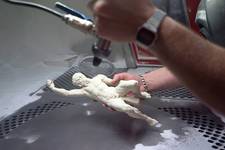 Propshop helps a team of experts in the task of identifying what might be the last known surviving bronze works of Michelangelo.
Propshop helps a team of experts in the task of identifying what might be the last known surviving bronze works of Michelangelo.
While everyone has heard of Michelangelo's David, and knows that the sculptor, painter and architect created some of his greatest sculptures in marble, little is known of the fact that he also worked extensively in other materials, including bronze. Many of the resultant works either lost to the ravages of time or the lack of corroborating evidence made it impossible to declare surviving pieces as definitively belonging to the hand of the renowned Rennaissance artist.
This, until very recently, has been the story of the Rothschild Bronzes, a wonderful pair of privately owned sixteenth century sculptures recently exhibited at the University of Cambridge's Fitzwilliam Museum. Once owned by the Rothschild family, the sculptures of two naked and drunk figures riding panthers were originally exhibited in 1878 as the work of Michelangelo, but the attribution was disputed, and the Bronzes have since been variously and tentatively attributed to a whole host of Rennaissance sculptors, including Aspetti, Sansovini, Cellini and, most recently, Fiammingo.
However, following the work of Cambridge-based Emeritus Professor of Art History Paul Joannide's connecting details of the Rothschild Bronzes to a similar drawing by one of Michelangelo's apprentices, a multidisciplinary team - of Cambridge art historians, Warwick University engineers, anatomists and imagers, conservation scientists from the Rijksmuseum in Amsterdam, the artist and renaissance bronze specialist Andrew Lacey and voxeljet's Propshop - was assembled to try help settle the question. If definitively attributed to Michelangelo, the Rothschild Bronzes would be the only known surviving examples of the artist's work in bronze.
As part of Andrew Lacey's task to investigate how Michelangelo's moulds were cast, helping to both place the work as being contemporary with the time in which Michelangelo worked and prove that its relatively poor finish is cognisant with what we know of early sixteenth century bronze casting methodology, Propshop was commissioned to use digital scan data to 3D print models at both reduced and small scale.
'It was a real honour to be asked to help,' says James Enright, Propshop's Managing Director and Asset Producer. 'Andrew's an extraordinary artist, a world leader in his respective field - as are the rest of the team. Once we had the scanned data we made the files print ready. We printed at a reduced scale of 200 mm and full scale at 750 mm , had them post-processed, and sent them off to Andrew.'
Printed on VX1000 printers, the Propshop 3D printed models were necessary for the level of anatomical and surface accuracy they provided Lacey and co-collaborator Robert van Langh, Head of the Department of Conservation and Restoration at the Rijksmuseum, both of whom presented papers at the Michelangelo Discovery Symposium held at the Fitzwilliam in Cambridge earlier this month.
'The Propshop models were vital to our findings,' says Lacey. 'There is no way that we could have come to our conclusions without the level of accuracy afforded by the prints. It's those details, as realised by the models, and with which we were able to work, which helped us place the Bronzes as contemporary to Michelangelo. It was great. The work stimulated enormous debate at the symposium. '
As well as Lacey and Langh's findings, another eight papers were presented by the Cambridge-led team, the field of expertise covering everything from questions as to who might have commissioned Michelangelo to create the moulds for the Bronzes to the significance of the rare anatomical accuracy of the figures to comparisons with the sculptor's other lost bronze works.
'It's very exciting,' says Enright. 'Nothing's been decided as of yet, but the case for the Bronzes belonging to Michelangelo is much stronger. I'm delighted that Propshop has been able to contribute to such a prestigious project, and to have helped create a significant digital record of these priceless works of art.' It's amazing to think that the detailed digital data of the artefact has now been archived and so the Rothschild Bronze in it's true glory will be able to live on forever in perpetuity.
www.voxeljet.com
































































































